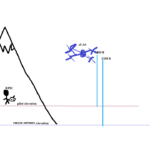Drones have been waiting in the batter’s circle of economics to step up to bat and take a swing at commercial integration. Amazon announced their new drone delivering system and sent the general public into a buzz. Some got excited at the novel idea, others remained skeptical, but either way it was a very popular topic (it was even on the kids TV show Sam and Cat.) However the Federal Aviation Administration simply banned commercial use. The idea of drones delivering that new Xbox in minutes quickly drowned in realistic problems with domestic economies.
The FAA was established to maintain a safe system of aviation for the U.S. However, they are also one of the most restricting systems now that aviation has also become a recreational hobby. Unmanned aircraft have become quite popular since they were first introduced, but FAA restrictions have made commercial application extremely difficult by banning such use. You cannot use a drone for a profit, unless specifically allowed by the FAA. I believe this stifles the expansion and integration of drones into our society. They could benefit our domestic economy greatly, but the FAA is taking only small steps toward this integration.
What counts as commercial use? Being paid for the service of your drone is an obvious violation of the ban. You cannot accept money for using your drone, anything that would cause income for you or any party involved is commercial use. However, that is only a direct violation, drones cannot be used commercially in an indirect manner as well. If the drone can be used to increase your reputation or assist in research involved in a company or party that receives income that can be considered commercial use as well, even if the research has no profitable value, the the FAA considers it an illegal, commercial use. Unfortunately for the FAA, there is no way to uphold the ban in all cases. Unless the commercial use is on a large scale, the FAA probably won’t even know. So I can go pay the neighborhood kid a couple bucks to fly his toy up to my roof to knock my football out of the gutters and not have FAA government officials arrive at my door.
Although the FAA seems to discourage commercial integration, they’ve been involved in many cases in which drones are being researched for commercial use. The FAA actually announced in August that a testing field in Rome, New York is open and operational. Two New York State crop researchers, Bill Verbeten and Mike Stanyard, have been given clearance to conduct research with their drone. The main focus of this site is research into agricultural scouting with drones. Drones have a bird’s eye view and could assist farmers in determining what sections of the grid of crops need attention and accomplishing tasks in a more timely manner. For example with a drone a farmer growing corn could do an aerial sweep of his large field of crops and find an area that is being poorly watered and adjust his irrigation accordingly. Anthony Foxx, the Secretary of Transportation, stated that although the drones still need to be pushed further to be integrated “the agricultural research performed in Rome also may have far-reaching benefits to farmers” across the nation. The FAA may be banning commercial use now, but they are allowing research into possible commercial uses in the future. They have even allowed some commercial uses in special cases today.
The FAA has taken a large step by announcing in late September that 6 film companies will be exempt from the non-commercial ban including: Astraeus Aerial, Aerial MOB, LLC, HeliVideo Productions, LLC, Pictorvision Inc, RC Pro Productions Consulting, LLC dba Vortex Aerial, and Snaproll Media, LLC. The Motion Picture Association of America represented the group of film companies in a request for their exemption to the FAA, who announced their exemption in a conference call. Anthony Foxx believes this is “a significant milestone in broadening commercial UAS use while ensuring we maintain our world-class safety record.” It is apparent that although safety is the main concern of the FAA, they are making efforts to allow drones to slowly integrate into domestic commercial use. By allowing the film industry to use drones to film, they have allowed more than simple research into future possibilities, this is one piece of the economy that has been freed from beneath the ban. A large contributor to the exemptions was the establishment of general guidelines and safety procedures designed for the group of companies such as keeping “the UAS within line of sight at all times and restrict flights to the ‘sterile area’ on the set.” The FAA claims that they will allow more exemptions through representatives of smaller companies and certain guidelines for those groups. As of September 25, the FAA is reviewing approximately 48 requests for exemption, one of which is Amazon.com to conduct testing in Seattle.
There is no doubt that the FAA is a little behind the technology of drones. Their fear can be considered irrational at times, but they are doing their best to catch up. The economy is constantly accelerating and fluctuating which may make it difficult for drones once the FAA catches up, if they ever do. But the opening of the research field in Rome, NY and the exemption of film companies are evidence that this ban, although restricting, isn’t permanent.


